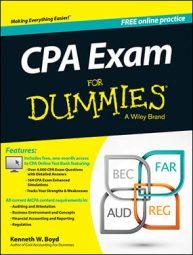The format of the regulation (REG) test on the CPA exam is the same format as the FAR and AUD tests. Regulation, however, is only a 3-hour exam. The test contains 72 multiple-choice questions (with 12 pretest items) and 6 simulations (with 1 pretest item).
Test-preparation companies recommend that you spend 110 to 140 hours studying for the REG test.
Getting an overview of taxation
One challenge on the REG test is the technical difficulty of taxation questions. This part of the test requires you to memorize many statistics. For example, you need to know the standard deduction an individual can take on his or her personal tax return.
Taxation is challenging because visualizing how the different facts and figures are connected is difficult. To help with this issue, take a look at the tax forms that contain these calculations.
Individuals file federal taxes using Form 1040. You can quickly download and print the 1040 form from the IRS website. Take a look at page 1 of Form 1040. The form starts with filing status and exemptions and then moves down to income. The REG test requires you to know facts about each section of the 1040.
As you study the tax concepts, find out where that topic is located on Form 1040. Connecting topics to the form will help you pull together the concepts. When you come across standard deductions, you’ll see that information is posted on page 2 of Form 1040.
You can use the same study process for other taxes. If you’re studying corporate tax topics, take a look at Form 1120, the corporate tax return form. Although you don’t necessarily need to memorize the tax form, it’s a great tool for understanding how tax topics relate.
Evaluating business entities
You need to understand the differences among types of business entities. The three in the following list are the most tested entities. Typically, a candidate needs to know how each of the entities is taxed. Also, the REG test may ask you about the legal liability that the business owners may encounter.
Sole proprietorship: This business has a single owner. Sole proprietorships are considered pass-through entities, which means that the business profit or loss flows to the owner’s individual tax return. So if the business earns $5,000 for the year, that $5,000 profit will be posted in income on the owner’s personal tax return (Form 1040). The owner has unlimited personal liability for all business-related litigation.
Partnership: A partnership is defined as an entity with two or more partners. The business profit or loss flows to each partner’s individual tax return. The amount of profit and loss assigned to a partner is determined in the partnership agreement.
If the partnership earns $20,000 for the year and the partnership agreement states that Bill earns 30 percent of the profit, $6,000 (30 percent of $20,000) will be posted to Bill’s personal tax return as income.
Each general partner has unlimited personal liability for all business-related litigation of the partnership. A limited partner’s liability is limited to the dollar amount she has invested in the partnership. The actions of one partner can cause legal liability for all of the partners.
Corporation: A corporation is defined as a tax and legal entity that’s separate from its owners. The corporation has two levels of taxation. First, profit and loss are calculated on a corporate tax return. The company pays tax on that profit.
Shareholders own common stock in the corporation. After paying taxes, the corporation may pay a dividend to shareholders. A dividend represents company earnings that are paid to shareholders. The dividend is then taxed on the shareholder’s personal tax return. The shareholder’s legal liability is limited to his common stock investment in the corporation.
Adding in business ethics
Ethics questions appear on the REG test. Reflecting a growing emphasis on ethics in the accounting field, most State Boards require annual continuing education with an ethics component. Federal and state governments as well as the media have increased their focus on ethics for business professionals.
In terms of auditing, independence means that a CPA’s only business relationship with the company is the fee for the audit work performed. The REG test may have other questions on independence. A question may ask whether a CPA has to be independent to perform a variety of other services, including compilations, reviews, agree-upon procedures, and tax return preparation.
The test emphasizes the importance of Board members who are independent. For a Board member to be independent, the only relationship with the company is the fee he or she receives to serve on the Board. Employees and company managers may serve as Board members in most cases. However, the test points out that independent Board members are more likely to provide unbiased opinions on company activities. Unbiased advice is highly valued.

